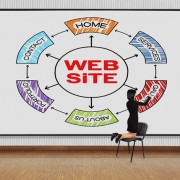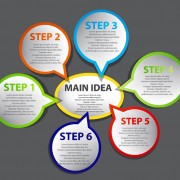7 Simple and Effective Landing Page Optimization Tactics
A landing page is the first impression visitors get of your website.
Since it’s difficult to change anyone’s first impression, you need to put your best efforts into designing a landing page that turns heads, and turns visitors into customers.
Some of you may remember the old days, when people interacted face-to-face, and there was no such thing as texting. I know, how barbaric!
Back then, it was said that a face-to-face first impression is formed in about 7 seconds, with the first 2 seconds being the most important. During those precious few seconds, you decide what kind of person you are meeting, how affluent they are, what level of education they’ve completed, and most importantly, whether they are similar to you.
And that’s just the first second. Seriously, by the time 7 or 8 seconds have flown by, you’ve created a whole background for this person more detailed than any Hollywood character breakdown.
It’s exactly the same with your landing page. In a few seconds the visitor decides how big, how successful and how old your company is, and how likely they are to trust you with their business.
If you think of your website landing page as the vestibule of your company, look at what Korean carmaker Hyundai did to crack the tough North American market. They hired the top designers in the world, not to design their cars, but to create dramatic new showrooms and entrances to their dealerships, unlike any the auto industry had ever seen.
It worked, big time. Consumers who had never heard of this new Hyundai brand were investing large chunks of their assets in it, wholly based on the look of the showrooms. Their slick website is nothing to sneeze at, either.
So that’s what you should aim for, making your landing page feel more like a state-of-the-art Hyundai showroom than the back office of a used car lot. Let’s get started.
1. Is Your Landing Page Too Busy?
It’s well known in the newspaper business that plenty of white space improves the reader’s experience and allows key messages the space they need to stand out. This is even more true for landing pages and website banners, where even the white space is alive with living, breathing pixels that bombard the senses.
Don’t make the mistake of trying to utilize every single nook and cranny on your page. Take a close look at every element and discard anything that doesn’t directly contribute to your user conversion rate. More is not better when it comes to landing page design, so lose the gaudy graphics and corny slogans, and take your cue from web design experts, who abhor any page that looks too busy. By the way, pixels don’t really breathe, but your landing page better have lots of breathing room.
2. Are you being too nosy?
A common mistake for novice marketers is to include forms that take too long to fill out and may be difficult to navigate. You don’t need to gather every piece of information you’ll ever need about this customer or potential client. You can do that later, once you have the contact information in your database.
Do you remember the heyday of Radio Shack’s retail dynasty? You could not purchase a pair of AA batteries in their store without first giving them your phone number. It was beyond annoying.
Radio Shack has since fallen off the radar, and no one ever called me to ask how those batteries were working out.
3. Does Your Landing Page Have All The Trappings Of A Legitimate Website?
Remember, there will always be a nagging question in the back of every web visitor’s mind, whether you’re in the business of B2B lead generation, content marketing, or you use social media for lead gen: Is this a legitimate business, or is the whole website run by an 11-year-old Filipino boy on a Fiverr project?
Make sure you include prominent links to your privacy policies, testimonials, and any awards or press material. Most people don’t want to read the fine print; they just like to know it’s there.
4. Does Your Landing Page Load Fast Enough?
When it comes to landing page optimization, it’s imperative to check the load speed across all platforms and all browsers. There are tools on the web to help calibrate the speed. If your page takes more than 6 or 7 seconds to open up, you may have a problem with the coding or with top-heavy graphics.
5. Is Your Picture Worth A Thousand Words?
Pictures and graphics are important to any page on the web, but they’re crucial to landing page optimization because of that darn first impression factor. Never steal anyone’s pictures or graphics. Instead, create original or buy some good stock photos (after you’ve shopped the photo licensing agency websites for at least 30 minutes).
It’s easy to find a colleague with a flair for photography who can take a few behind-the-scenes pictures. Those candid shots really make your business appear friendlier and more approachable; just make sure every face in every picture has a smile on it.
6. Does Your Landing Page Solve Their Problem?
We have to assume that a visitor was directed to your landing page because they have a problem that needs to be solved. Therefore, you have to highlight the out-and-out benefits for them as soon as the page loads.
Is their problem a lack of money? Show them how you can save them money, or help them make more money. Perhaps their problem is that they don’t have the time or expertise to execute a plan, or that they need business solutions to a recurring problem. Let them know exactly how you can solve their problem.
7. Is Your Landing Page Optimization Search Engine Friendly?
Chances are, if you’re involved with B2B marketing and lead generation, you’re running and testing multiple landing pages that are nearly identical except for slight variations in text or graphics. If that’s the case, be sure to make your main landing page available for search engine indexing, but employ robots.txt or meta tags for your ‘”sister” sites. This ensures that you don’t have duplicate copy showing, which would put you in Google’s bad books.
Above all, keep working on your landing page optimization. You can never change a visitor’s first impression of your landing page, but you can always change the landing page.










